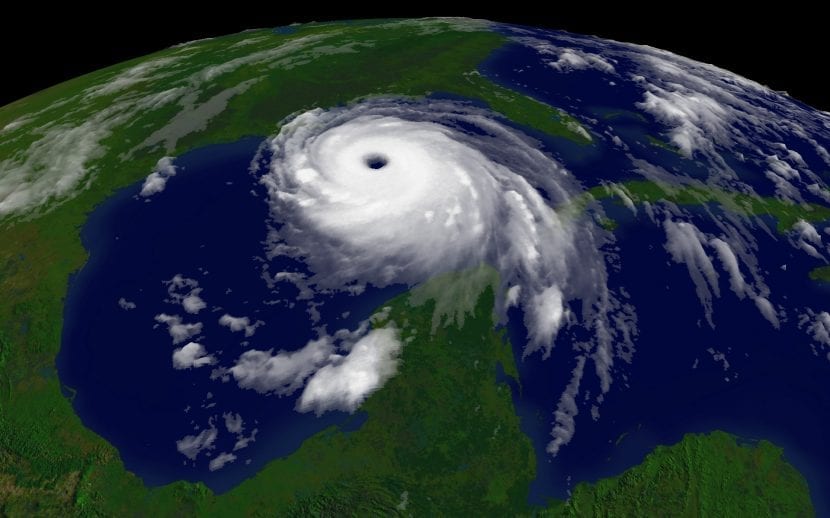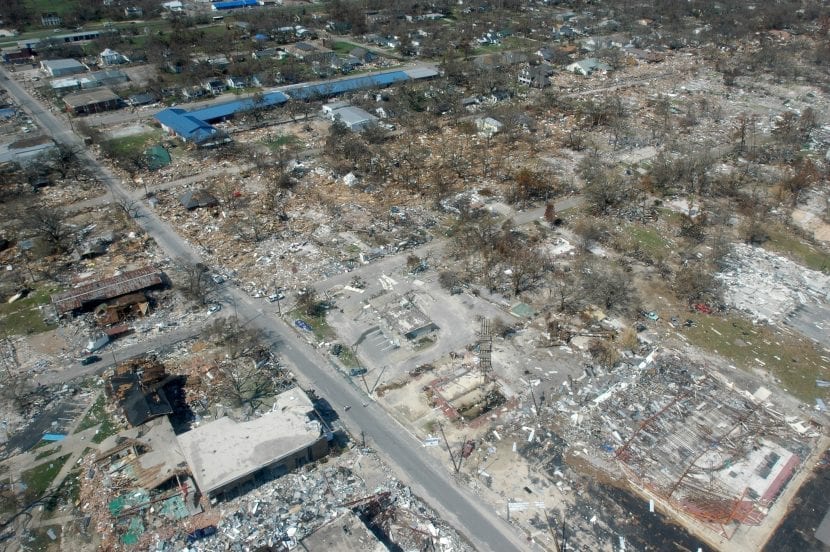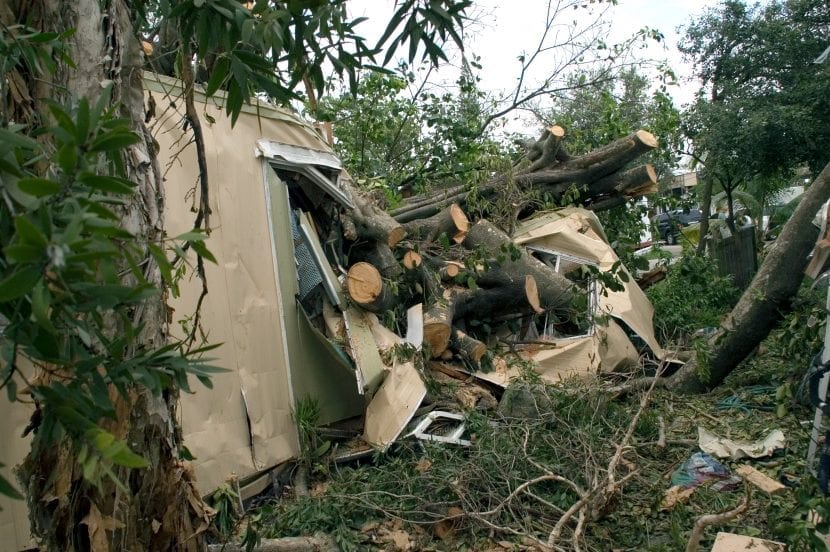
Hurricane Katrina, as seen by NOAA's GOES-12 satellite.
Meteorological phenomena are events that usually cause damage, but not as much as those caused by the Hurricane Katrina. At least 1833 people died from the hurricane itself or the flooding that accompanied it, making it the deadliest of the 2005 Atlantic hurricane season, and the second in U.S. history, behind only San Felipe II, 1928.
But What is the origin and trajectory of this powerful hurricane that, just by saying its name, the images of destruction it left in the United States immediately come to mind?
Hurricane Katrina history

Katrina's trajectory.
To speak of Katrina is to speak of New Orleans, Mississipi, and other countries that suffered from the passage of this tropical storm. It is the twelfth cyclone that formed in the hurricane season of 2005, specifically on August 23, in the southeast of the Bahamas. It was the result of the confluence of a tropical wave and Tropical Depression Diez, formed on August 13.
The system reached tropical storm status just one day later, on August 24, the day it would be renamed Katrina. The trajectory that followed was the following:
- 23 August: headed towards Hallandale Beach and Aventura. Upon making landfall it weakened, but an hour later, upon entering the Gulf of Mexico, it intensified again and regained its hurricane status.
- 27 August: It reached category 3 on the Saffir-Simpson scale, but a cycle of replacement of the eye wall caused it to double in size. This rapid intensification was due to the unusually warm waters, which caused the wind to blow faster. Thus, the next day it reached category 5.
- 29 August: Made landfall for the second time as a Category 3 hurricane near Buras (Louisiana), Breton, Louisiana and Mississipi with 195km / h winds.
- 31 August: it degraded to a tropical depression near Clarksville (Tennessee), and continued its way to the Great Lakes.
Eventually, it became an extratropical storm that moved northeastward and affected eastern Canada.
What measures were taken to avoid damage?
The National Hurricane Center (CNH) issued a hurricane watch for southeastern Louisiana, Mississipi and Alabama on August 27 after reviewing the possible path that the hurricane would follow. That same day, the United States Coast Guard carried out a series of rescue operations from Texas to Florida.
The then president of the United States, George W. Bush declared a state of emergency in Louisiana, Alabama and Mississippi on August 27. In the afternoon, the CNH issued a hurricane warning for the coastal stretch between Morgan City (Louisiana) and the border between Alabama and Floridatwelve hours after the first warning.
Until then, no one could have an idea of how destructive Katrina would end up being. A bulletin was issued from the New Orleans / Baton Rouge office of the National Weather Service warning that the area could remain uninhabitable for weeks. On August 28, Bush spoke with Governor Blanco to recommend a mandatory evacuation from New Orleans.
In all, some 1,2 million people from the Gulf Coast as well as most of those in New Orleans had to be evacuated.
What damage did it cause?

This is how Mississipi was left after the hurricane.
Deceased
Hurricane Katrina killed 1833 people: 2 in Alabama, 2 in Georgia, 14 in Florida, 238 in Mississipi and 1577 in Louisiana. In addition, there were 135 disappeared.
Material damage
- At southern Florida and Cuba there was damage estimated at one to two billion dollars, mainly due to flooding and downed trees. There was significant rainfall in Florida, with 250mm, and in Cuba, with 200mm. The Cuban city of Batabanó was 90% flooded.
- En Louisiana the rainfall was also intense, from 200 to 250mm, which caused the level of Lake Pontchartrain to rise, which in turn flooded the towns between Slidell and Mandeville. The I-10 Twin Span Bridge, which linked Slidell and New Orleans, was destroyed.
- En New Orleans the rains were so intense that the entire city was practically flooded. In addition, Katrina caused 53 breaches in the levee system that protected it. The roads were inaccessible, except for the Crescent City Connection, so they could only leave the city for it.
- En Mississippi, caused damage estimated in billions of dollars in bridges, boats, cars, houses and piers. The hurricane tore through it, resulting in 82 counties declared catastrophic federal aid zones.
- At Southeastern US winds of 107km / h were recorded in Alabama, where four tornadoes also formed. Dauphin Island was badly damaged. As a consequence of the hurricane, the beaches were eroded.
As it headed north and weakened, Katrina was still strong enough to cause flooding in Kentucky, West Virginia, and Ohio.
In total, property damage was estimated at $ 108 million.
Environmental impact
When we talk about hurricanes we tend to think of the damage they cause to cities and towns, which is of course logical since we make our lives in those places. However, it sometimes happens that one of these phenomena causes serious damage to the environment. And Katrina was one of them.
Ravaged about 560km2 of land in Louisiana, according to him United States Geological Survey, areas where there were brown pelicans, turtles, fish and numerous marine mammals. And not only that, but sixteen national wildlife refuges had to be closed.
In Louisiana, there were oil spills at 44 facilities in the Southeast, which translated into 26 million liters. Most were controlled, but others reached the ecosystems and the city of Meraux.
Effects on the human population
When you lack food and water, you do whatever it takes to get it. But you won't be the only one looting and stealing - so will violent people. That was precisely what happened in the United States. The United States National Guard deployed 58.000 troops to try to control the cities, although they did not have it easy: the homicide rate from September 2005 to February 2006 grew by 28%, reaching 170 murders.
Were the appropriate measures taken?

Damaged house in Florida after Hurricane Katrina.
There are those who think that the United States Government did not do everything possible to avoid human losses. Rapper Kanye West at a benefit concert on NBC he said that "George Bush doesn't care about black people." The former president responded to this accusation by saying that this was the worst moment of his presidency, having unfairly accused of racism.
John prescott, former Deputy Prime Minister of the United Kingdom, said that »the terrible flood in New Orleans brings us closer to the concerns of leaders of countries like the Maldives, whose nations are at risk of disappearing completely. The United States has been reluctant to the Kyoto protocol, which I consider a mistake.
Despite what happened, many countries wanted to help Katrina survivors, either by sending money, food, medicine or whatever they could. The international aid was so great that of the 854 million dollars they received, they only needed 40 (less than 5%).
Hurricane Katrina left its mark on the United States, but I think a little on all of us as well. It was one of the most important representations of the force of nature. A nature that is there, taking care of us most of the time, and sometimes putting us to the test.